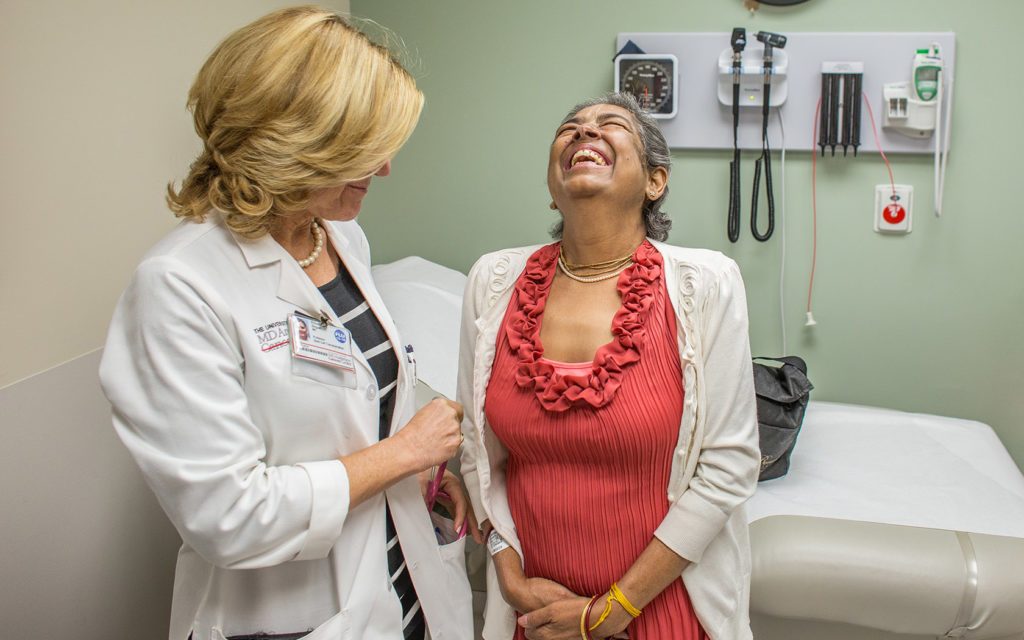Chemistry professor Bindu Chakravarty rarely missed a day teaching at Houston Community College. So when she called in sick one morning, it was with good reason. “I had a 101-degree fever and was so exhausted, I could barely get out of bed,” she remembers. “Something was very wrong.”
“I had a 101-degree fever and was so exhausted, I could barely get out of bed,” she remembers. “Something was very wrong.”
For several weeks, Chakravarty, 59, had been fatigued and running a low-grade fever. But she took aspirin and kept on going.
“I thought whatever illness I was fighting would run its course,” she says. “I didn’t want to let my students down.”
When aspirin ceased to work and her fever spiked, Chakravarty’s worried husband insisted she visit a doctor. Instead of going to class, she headed to her family physician’s office.
A blood test revealed her platelets — cells in the blood that help it clot — were low. The doctor explained that this can cause excessive bruising and bleeding.
“Now I understood why my gums bled when I brushed my teeth,” Chakravarty recalls, “and why I was covered in bruises.”
Because a low platelet count can be a red flag for leukemia, Chakravarty’s doctor referred her to an oncologist at MD Anderson, where tests revealed she had a cancer of the blood called acute myeloid leukemia, or AML.
“I was admitted to the hospital the next day,” Chakravarty says, “and my cancer journey began.”
The treatment plan
Early tests at MD Anderson revealed Chakravarty had a form of AML that’s linked to a genetic mutation and is particularly aggressive.
“Though AML starts in the bone marrow, it can quickly move into the blood and sometimes spread to other parts of the body, including the lymph nodes, liver, brain and spinal fluid,” says Elizabeth Shpall, M.D., deputy chair of Stem Cell Transplantation and Cellular Therapy at MD Anderson.
Treatment began immediately. First, doctors in the Leukemia Department prescribed several rounds of intense chemotherapy to wipe out the cancer cells in her bone marrow.
The treatment can be effective, but it has an unwanted side effect: Healthy red and white blood cells and platelets become “collateral damage” and are killed along with the cancer cells by the chemo. This makes the body vulnerable to infection and uncontrolled bleeding.
For her own protection, Chakravarty spent 27 days in isolation until tests showed no remaining signs of cancer. Next came the second phase of treatment — a stem cell transplant to replenish her bone marrow with healthy stem cells from a matching donor.
To test whether a donor is a suitable match for a recipient, doctors examine genes in the human leukocyte antigen, or HLA System — the part of the immune system that recognizes self and not self. In a full match, eight or more of the HLA genes need to match between donor and recipient. When stem cells are derived from another source — donated umbilical cord blood — a match in four of six HLA markers is considered acceptable for most patients.
None of Chakravarty’s family members qualified as a match, nor did any of the 28 million people who signed up as donors with various registries. So Shpall recommended using blood collected from an umbilical cord immediately following the delivery of a baby.
After the umbilical cord is cut, a needle is inserted into the vein of the cord, and the blood in the cord and placenta is collected and frozen until it’s needed for a transplant.
This infant blood is rich in new stem cells that haven’t yet been educated against foreign invaders, reducing the chances they’ll attack a recipient’s tissues.
“The nice thing about cord blood is it contains a large number of stem cells that are naïve,” Shpall explains. “So they’re less likely to cause complications in recipients. For this reason, we don’t need a full match when we use cord blood.”
The number of stem cells in one unit of umbilical cord blood, however, is not enough to repopulate the bone marrow of an adult. So after more mild chemo and radiation to kill any straggling cancer cells, Chakravarty underwent a double cord transplant, in which blood from two umbilical cords is combined to provide a sufficient number of stem cells.
The procedure is essentially painless, Shpall says, and is similar to a blood transfusion. The donated stem cells are thawed and infused into the recipient’s vein through an IV. The stem cells then naturally migrate into the bone marrow. The restored bone marrow begins producing normal blood cells within several days to several weeks.
“In some cases, the transplant can have an added benefit,” Shpall says. “The new blood cells also attack and destroy any cancer cells that survived the chemo and radiation.”
Age isn’t everything
While stem cell transplants may be lifesaving, not everyone is a candidate.
When approving a transplant, doctors take into account the patient’s overall physical condition, diagnosis, stage of disease and previous treatments. Tests are conducted to make sure the patient is healthy enough to undergo the procedure.
Stem cell transplants traditionally have been offered to children and young adults, though, ironically, blood cancers most often affect older patients.
“In the past, older adults had more complications with stem cell transplants, mainly due to the high levels of chemo and radiation required before the procedure,” Shpall explains. “Today, we’ve reduced the toxicity of these pre-treatment regimens.”
Doctors now are more likely to evaluate older patients on an individual basis, Shpall says, and to consider physiological age instead of chronological age when deciding who’s eligible for a transplant.
Read more about the different types of stem cell transplants available in the fall 2016 issue of Conquest magazine.


